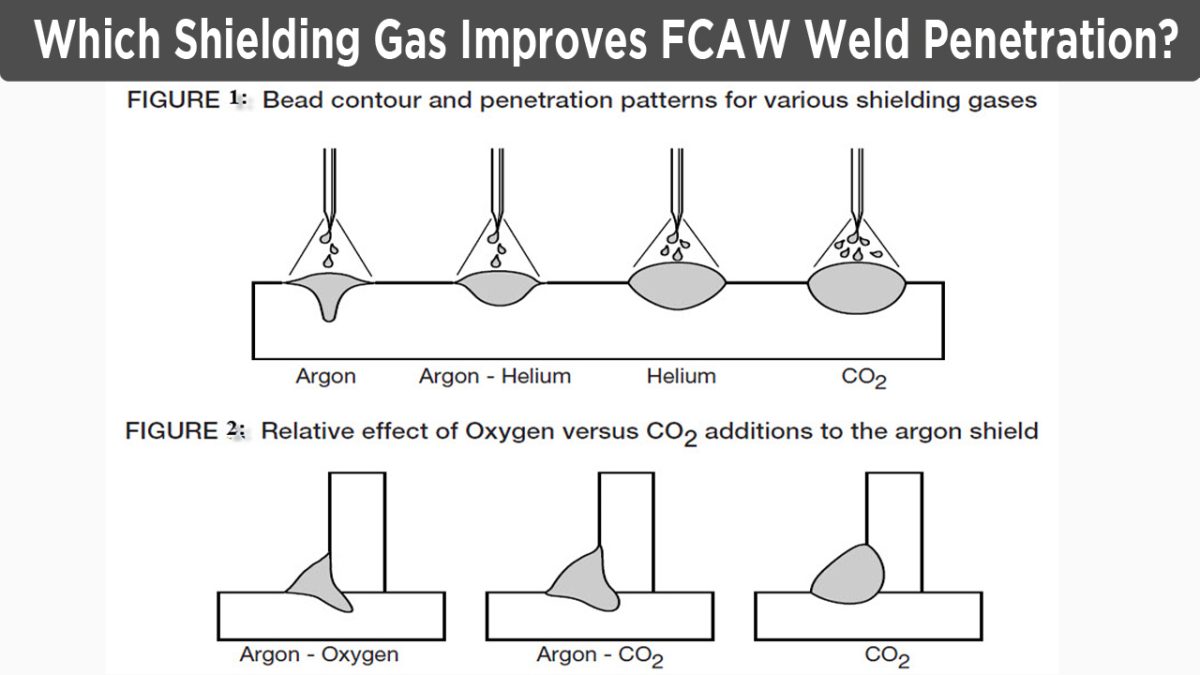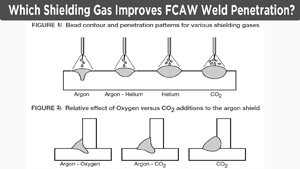Looking to enhance the penetration of your flux-cored arc welding (FCAW) welds? The choice of shielding gas can greatly influence the outcomes. In this article, we will explore the different shielding gases and their impact on FCAW weld penetration.
When it comes to FCAW, selecting the right shielding gas is essential to achieve optimal weld quality. The primary function of the shielding gas is to protect the weld pool from atmospheric contaminants, such as oxygen and nitrogen, which can negatively affect penetration and lead to defects.
Various shielding gases can be used for flux-cored arc welding, including carbon dioxide (CO2), argon (Ar), and argon/carbon dioxide mixtures. Each gas has unique properties and affects weld penetration differently. While CO2 is commonly used due to its affordability, it may not provide the desired level of penetration in certain applications. Argon, on the other hand, tends to produce a narrower and deeper weld profile, resulting in improved penetration.

Photo by weldinganswers
Weld Penetration in FCAW Welding
Weld penetration refers to the depth to which the weld metal fuses with the base metal. In FCAW welding, achieving adequate penetration is crucial for creating strong and reliable welds. Insufficient penetration can lead to weak joints and potential failures under stress.
Proper weld penetration ensures that the weld metal fully fills the joint, creating a robust bond between the two pieces being welded. This is especially important in applications where the welds are subjected to high loads or exposed to harsh environments. Without sufficient penetration, the weld can become a weak point, compromising the overall structural integrity.
Overview of Different Shielding Gases Used in FCAW Welding
In FCAW welding, shielding gases play a vital role in protecting the molten weld pool from atmospheric contamination. They also influence the weld penetration characteristics. Let’s take a closer look at the three commonly used shielding gases in FCAW welding:
Carbon Dioxide (CO2)
CO2 is a popular choice due to its affordability and wide availability. It provides good arc stability and can produce satisfactory weld penetration in many applications. CO2 can result in a wider and shallower weld bead profile compared to other gases, which may not be ideal for certain projects requiring deep penetration.
Argon (Ar)
Argon is an inert gas that is often used in combination with CO2 to improve the weld quality and penetration. When used alone, argon produces a narrower and deeper weld profile, enhancing penetration. It provides excellent arc stability and reduces the risk of spatter. Using pure argon as a shielding gas can be expensive and may not be cost-effective for all applications.
Argon/Carbon Dioxide Mixtures
A blend of argon and carbon dioxide can offer a balance between cost and performance. These mixtures can provide good penetration while maintaining reasonable cost-effectiveness. The exact ratio of argon to CO2 can be adjusted based on the desired weld characteristics and project requirements.
Comparing the Effects of Different Shielding Gases on Weld Penetration
The choice of shielding gas can significantly impact the weld penetration in FCAW. Let’s compare the effects of the different shielding gases on weld penetration:
Carbon Dioxide (CO2)
As mentioned earlier, CO2 can provide satisfactory weld penetration in many applications. Due to its wider and shallower weld bead profile, it may not be the best choice for projects that require deep penetration. CO2 is often used in applications where cost is a major concern.
Argon (Ar)
Argon tends to produce a narrower and deeper weld profile, resulting in improved penetration. It offers better control over the weld pool and reduces the risk of defects. The use of pure argon can be expensive, making it more suitable for high-quality welding applications where penetration is critical.
Argon/Carbon Dioxide Mixtures
These mixtures offer a good balance between cost and performance. By adjusting the ratio of argon to CO2, welders can fine-tune the weld penetration characteristics to meet the specific project requirements. These mixtures are commonly used in a wide range of applications and provide satisfactory penetration at a reasonable cost.
Factors to Consider When Selecting the Appropriate Shielding Gas for FCAW Welding
Choosing the right shielding gas for FCAW welding requires careful consideration of various factors. Here are some key factors to keep in mind:
Weld Penetration Requirements
Assess the project requirements and determine the desired weld penetration depth. Consider the material thickness, joint design, and specific application to determine the appropriate level of penetration.
Cost Considerations
Evaluate the cost-effectiveness of different shielding gases. While pure argon may offer excellent penetration, it might not be financially viable for all projects. Balance the desired weld quality with the available budget to make an informed decision.
Material Compatibility
Different materials may require different shielding gases to achieve optimal penetration. Consider the base metal composition and consult material-specific guidelines to select the appropriate shielding gas.
Welding Position
Welding in different positions, such as flat, horizontal, vertical, or overhead, can affect the weld penetration. Certain shielding gases may perform better in specific positions, so consider the welding position when choosing the shielding gas.
Testing and Evaluating the Weld Penetration with Different Shielding Gases
To determine the optimal shielding gas for your FCAW welding application, it is essential to conduct tests and evaluate the weld penetration characteristics. Here’s a step-by-step approach to testing and evaluating weld penetration:
Prepare Test Specimens
Create test specimens using the same material and joint design as your actual project. Ensure that the specimens are representative of the welding conditions and requirements.
Set Up Welding Parameters
Establish consistent welding parameters, such as voltage, amperage, wire feed speed, and travel speed, for all tests. This will help eliminate variables and ensure accurate evaluation of the shielding gas impact on weld penetration.
Conduct Test Welds
Perform multiple test welds using different shielding gases, including CO2, argon, and argon/carbon dioxide mixtures. Ensure that the welding technique and parameters remain consistent throughout the tests.
Evaluate Weld Penetration
After completing the test welds, carefully examine the weld beads and assess the level of penetration achieved. Measure the depth of penetration and compare the results obtained with different shielding gases.
Analyze and Compare Results
Analyze the data collected from the test welds and compare the weld penetration achieved with each shielding gas. Consider other factors, such as weld quality, spatter, and bead appearance, to make a comprehensive assessment.
Best Practices for Achieving Optimal Weld Penetration in FCAW Welding
To achieve optimal weld penetration in FCAW welding, follow these best practices:
Clean and Prepare the Joint
Ensure that the joint surfaces are clean and free from contaminants, such as rust, oil, or paint. Proper joint preparation promotes better fusion and penetration.
Use the Correct Wire Diameter
Select the appropriate wire diameter for the desired penetration. Thicker wires generally provide deeper penetration, while thinner wires are suitable for shallow welds.
Adjust Welding Parameters
Fine-tune the welding parameters, such as voltage, amperage, and travel speed, to achieve the desired penetration. Experiment with different settings and monitor the results to optimize weld penetration.
Maintain Appropriate Arc Length
Maintain a consistent arc length throughout the welding process. An excessively long or short arc can affect the weld penetration and quality.
Consider Preheating
Preheating the base metal can improve weld penetration, particularly in applications involving thicker materials. Consult the material specifications and preheat the joint if necessary.
Practice Proper Technique
Ensure that you are using the correct welding technique for the desired penetration. Maintain a steady hand, control the travel speed, and employ proper weaving or oscillation techniques when required.
Common Challenges and Troubleshooting Tips
While striving for optimal weld penetration in FCAW welding, welders may encounter certain challenges. Here are some common issues and troubleshooting tips:
Insufficient Penetration
If the weld penetration is inadequate, consider increasing the wire diameter, adjusting the welding parameters, or improving joint preparation. Preheating the base metal can also help achieve deeper penetration.
Excessive Penetration
If the weld penetration is too deep, use a thinner wire diameter, reduce the welding parameters, or adjust the shielding gas composition to achieve a shallower weld bead.
Uneven Penetration
Uneven penetration can occur due to inconsistent travel speed, improper weaving technique, or incorrect arc length. Practice consistent technique and ensure proper control over the welding parameters to achieve even penetration.
Spatter and Porosity
Spatter and porosity can negatively impact weld penetration. Ensure that the welding surface is clean, adjust the shielding gas flow rate, and optimize the welding parameters to minimize spatter and porosity.
Case Studies Demonstrating the Impact of Different Shielding Gases on Weld Penetration
To illustrate the impact of different shielding gases on weld penetration, let’s examine a couple of case studies:
Case Study 1
A construction project requires deep penetration welds on thick steel plates. The welder tests CO2, argon, and an argon/carbon dioxide mixture. The results show that CO2 provides satisfactory penetration but produces wider beads. Argon produces narrower and deeper welds, while the argon/carbon dioxide mixture offers a balance between penetration and cost-effectiveness.
Case Study 2
A fabrication workshop is welding aluminum components. The welder tests pure argon and an argon/carbon dioxide mixture. The results reveal that pure argon provides excellent weld penetration, but the cost is prohibitive for large-scale production. The argon/carbon dioxide mixture offers satisfactory penetration and proves to be more cost-effective for this application.
Conclusion and Recommendations for Selecting the Right Shielding Gas
The choice of shielding gas plays a crucial role in achieving optimal weld penetration in FCAW welding. While carbon dioxide (CO2) is commonly used due to its affordability, it may not provide the desired level of penetration in certain applications. Argon, on the other hand, tends to produce a narrower and deeper weld profile, resulting in improved penetration. Argon/carbon dioxide mixtures offer a balance between cost and performance.
When selecting the appropriate shielding gas, consider factors such as weld penetration requirements, cost considerations, material compatibility, and welding position. Conduct tests to evaluate the weld penetration characteristics with different shielding gases. Follow best practices, troubleshoot common issues, and learn from case studies to optimize weld penetration in FCAW welding.
